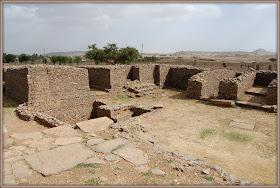 |
| Salomon de Bray, 1657 |
The Queen of Sheba is known to Ethiopians as Makeda and I will likely interchangeably refer to her as Makeda and the Queen of Sheba throughout this post.
In Ethiopian tradition the Queen of Sheba would have reigned around the time of the Kingdom of D'mt and she is said to have hailed from the Agamé region of Ethiopia born to the Irob people . The Irob people are an ethnic group who occupy a predominantly highland, mountainous area in northeastern Tigray by the same name.
In Ethiopian tradition the Queen of Sheba would have reigned around the time of the Kingdom of D'mt and she is said to have hailed from the Agamé region of Ethiopia born to the Irob people . The Irob people are an ethnic group who occupy a predominantly highland, mountainous area in northeastern Tigray by the same name.
There has long been an argument over whether the 'real' Queen of Sheba either lived and reigned in Yemen, or lived and reigned in Ethiopia. Those conflicting theories are starting to be challenged though. While in conversation in Adigrat I frequently heard that there are reasons to question whether her kingdom might have stretched across the two territories. There are similar cross Red Sea working theories for where "The Land of Punt" was located. Excavations do suggest a connection between the two peoples, there is a smattering of Sabean pottery in northern Ethiopia and Sabean script written here and there.
It has been suggested that one specific site currently being excavated may be the ruins of a massive underground residence of the Queen of Sheba . A group of archeologists have begun uncovering the ruins in Gulo-makeda which is a district found right next to Irob. The district's name is derived from the Queen of Sheba's Ethiopian name, "Makeda". There is evidence that a sophisticated community of people have been residing in Gulo-makeda for 3,000 years .
 |
| grounds of a church in Gulomakeda |
 |
| Still shot from documentary footage |
In 2008 a group from the University of Hamburg excavated underneath Dungur Palace in Axum (west of Agamé) and found the base of a much earlier structure they believe may also have been a residence of Makeda's . Dungur Palace has been locally and popularly known as a palace of Makeda's but the visible ruins most people visit had been dated at a much later time frame than when Makeda lived. Who knows what a wealth of discovery lies beneath Dungur.
 |
| Inside Dungur Palace in Axum |
| Makeda is said to have given birth to her son Menelik on the banks of the Mai Bela river. The Mai Bela river was located in Asmara and it was filled in during 1936-37 in order to create a major traffic route, now called Mai Bela Avenue. |
|---|
 |
| Emperor Yohannes |
The strong widespread belief that The House of Agamé came from the Queen of Sheba's line quite certainly helped preserve its long legacy of influence in the region. The House of Agamé was simultaneously seen as a threat to every ambitious heart wanting to rule large sections of the country and a House to align oneself with , marry into or claim connection to (even in the most remote way) in order to ensure public opinion was on your side and you retained your privileged position for as long as possible. The public's commitment to members of the House of Agamé remained so strong throughout the many generations that even in 1936 there was a recognition that it would not be a good idea for Mussolini's troops to slight the family because they had 'exercised command for generations' and had too much 'authority and prestige'.* Bizunesh Atsbeha would have been a little girl around then and her mom and dad, Kassa and Atsbeha would have indeed still been fairly influential in the region at that time.
It is not only the feudalist history in Ethiopia that has been shaped by the stories of Makeda, she is also a heavyweight in the Ethiopian Orthodox Church. The Ark of the Covenant coming to Axum is tied to her story and the story of her son . The Kebra Negast or the The Glory of the Kings is a 14th century textual account of the origins of the Solmonic line in Ethiopia and it is considered by many Ethiopian Christians and Rastafarians to be an inspired and a reliable work. As Edward Ullendorff explained in the 1967 Schweich Lectures, "The Kebra
Nagast is not merely a literary work, but—as the Old Testament to the
Hebrews or the Qur'an to the Arabs—it is the repository of Ethiopian
national and religious feelings." The story of Makeda and how the Ark of the Covenant came to Ethiopia has been described as the center piece of the Kebra Nagast. The
Ark itself is considered to be so central in the Ethiopian Orthodox faith that
it is actually believed a church is just a building and not really a
church unless it has a replica of the Ark, an item called the tabot. A tabot that was brought into the monumentally important Battle of Adwa is said to have helped the Ethiopians win against the Italians. A win that decisively ended any European power's dream of colonizing the country.
* thoughts about how the Agamé people and the House of Agamé dealt with the Italians invading their land in the 1890s and the Italian occupation in the 1930s deserve a separate post.
02/19/16 Correction: A previous version of this blog post incorrectly labelled a depiction of Emperor Téwodros II as Emperor Yohannes.







